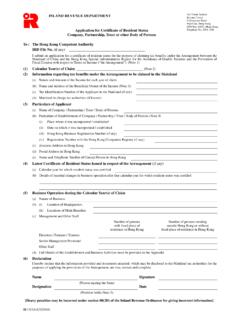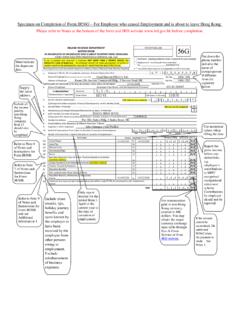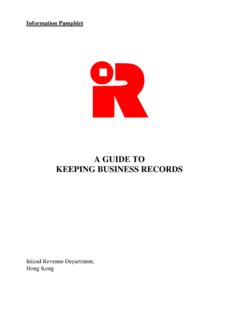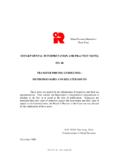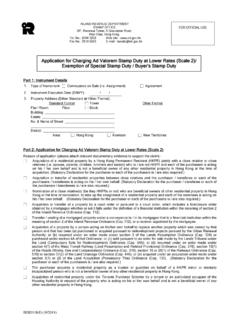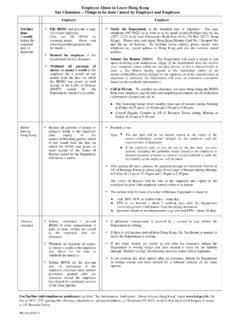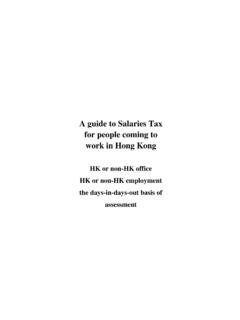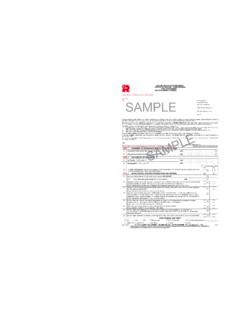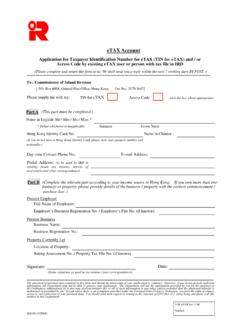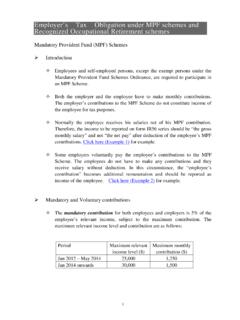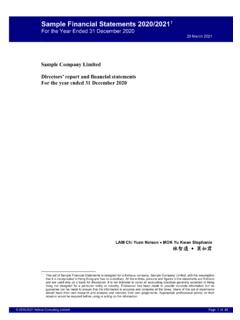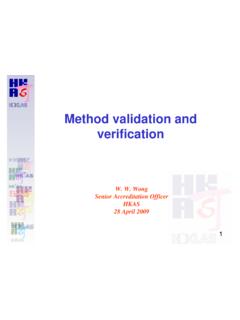Transcription of Departmental Interpretation And Practice Notes - No. 42
1 Inland Revenue Department The Government of the Hong Kong Special Administrative Regionof the People's Republic of China Departmental Interpretation AND Practice Notes NO. 42 (REVISED) PROFITS TAX PART A: TAXATION OF FINANCIAL INSTRUMENTS PART B: TAXATION OF FOREIGN EXCHANGE DIFFERENCES These Notes are issued for the information of taxpayers and their tax representatives. They contain the Department s Interpretation and practices in relation to the law as it stood at the date of publication. Taxpayers are reminded that their right of objection against the assessment and their right of appeal to the Commissioner, the Board of Review or the Court are not affected by the application of these Notes .
2 These Notes replace those issued in November 2005. WONG Kuen-fai Commissioner of Inland Revenue June 2020 Our web site : Departmental Interpretation AND Practice Notes No. 42 (REVISED) CONTENT Paragraph Introduction Gains or losses on financial instruments 1 Foreign exchange differences 3 Part A : Taxation of Financial Instruments Taxable profits Principles of commercial accounting 4 The two cardinal principles 5 Interim measure 6 Legislative amendments 8 Accounting treatment of financial instruments Hong Kong Financial Reporting Standards 9 Definitions of terms 12 Basis for profits tax assessment Realization basis 13 Fair value basis 14 Election for assessment on fair value basis Conditions for adopting fair value basis for assessment 15 Irrevocable election 19 Revocation of election 20 Assessment on fair value basis Alignment of tax treatment and accounting treatment - Tax relevant amount equals accounting relevant amount 24 - Financial assets
3 Measured at amortized cost 26 - Financial assets measured at fair value through other 27 comprehensive income - Financial assets measured at fair value through profit 28 or loss - Financial liabilities measured at amortized cost 29 - Financial liabilities measured at fair value through 30 profit or loss Special treatment of impairment loss - Expected credit losses 31 - Non-credit-impaired financial assets 32 - Credit-impaired financial assets 33 - Purchased or originated credit-impaired financial 39 assets - Transfer of credit-impaired loans 40 Other special treatments - Equity instruments 44 - Financial liabilities changes in credit risk 47 - Embedded derivatives convertible debt security 49 - Preference shares 51 - Non-arm s length loans 53 - Hedging instruments 57 Reclassification 60 Tax adjustment for change of assessment basis - From realization basis to fair value basis 62 - From fair value basis to realization basis 63 Transitional accounting adjustments 66 Impact on other Part 4 provisions - Regulatory capital securities 68 - Interaction with other Part 4 provisions 69 Ta x avoidance arrangements Section 61A 73 Relevant tax cases 74 Effective date 76 ii Part B.
4 Taxation of Foreign Exchange Differences Foreign currency transactions Foreign currencies 77 Accounting treatment 78 Relevant tax cases 84 Unrealized exchange differences 89 Appendices of HKFRS Practiceiii INTRODUCTION Gains or losses on financial instruments Hong Kong is a major financial centre in the Asia Pacific region and financial instruments are widely used in Hong Kong to achieve investment, trading or hedging objectives. Since financial instruments have become increasingly complex, detailed financial reporting standards have been developed to deal with the related accounting issues. Against this background, Hong Kong Financial Reporting Standard 9 Financial Instruments (HKFRS 9) has been issued, setting o ut the requirements for recognizing and measuring financial assets, financial liabilities and some contracts to buy or sell non-financial items.
5 Inland Revenue (Amendment) (No. 2) Ordinance 2019 wasenacted to provide for the alignment of tax treatment of financial instruments with their accounting treatment. Part A of this Departmental Interpretation and Practice Note (DIPN) sets out the Department s views and practices regarding the tax treatment of gains or losses in respect of financial instruments to which HKFRS 9 applies. Foreign exchange differences Hong Kong, business is often transacted in foreign or losses will result from such transactions due to the fluctuation in the rates of exchange of the foreign currencies. Hong Kong Accounting Standard 21 The Effects of Changes in Foreign Exchange Rates provides guidance on the translation method and on determining the functional and presentation currencies.
6 Part B of this DIPN explains the Department s views and practices regarding the tax treatment of foreign exchange differences. 2 PART A: TAXATION OF FINANCIAL INSTRUMENTS TAXABLE PROFITS Principles of commercial accounting tax is charged on every person carrying on a trade, professionor business in Hong Kong in respect of his assessable profits arising in or derived from Hong Kong. The Inland Revenue Ordinance (the Ordinance) itself does not contain a comprehensive definition of the term assessable profits . In CIR v Secan Ltd & Another (2000) 3 HKCFAR 411, the Court of Final Appeal established the principle that the assessable profits or losses of a taxpayer must be ascertained in accordance with the ordinary principles of commercial accounting, as modified to conform with the Ordinance.
7 Delivering the unanimous decision of the Court, Lord Millett NPJ said at page 419: Both profits and losses therefore must be ascertained in accordance with the ordinary principles of commercial accounting as modified to conform with the Ordinance. Where the taxpayer s financial statements are correctly drawn in accordance with the ordinary principles of commercial accounting and in conformity with the Ordinance, no further modifications are required or permitted. Where the taxpayer may properly draw its financial statements on either of two alternative bases, the Commissioner is both entitled and bound to ascertain the assessable profits on whichever basis the taxpayer has chosen to adopt.
8 The t wo cardinal principles Nice Cheer Investment Ltd v CIR (2013) 16 HKCFAR 813, theCourt of Final Appeal, further elaborated what constitutes taxable profits within the meaning of the Ordinance. Lord Millett NPJ said at page 825: There are two cardinal principles of tax law: (i) the word profits connotes actual or realized and not potential or anticipated profits; and (ii) neither profits nor losses may be anticipated. 3 He further explained at page 829: In the present case the subject matter of the tax is profit , and the question what constitutes a taxable profit is a question of law. While the amount of that profit must be computed and ascertained in accordance with the ordinary principles of commercial accounting, these are always subject to the overriding requirement of conformity, not merely with the express words of the statute, but with the way in which they have been judicially interpreted.
9 Interim measure 6. Following the judgment of the Court of Final Appeal in Nice Cheer, taxable profits, though computed and ascertained in accordance with the ordinary principles of commercial accounting, will be subject to the two cardinal principles of tax law. 7. Financial institutions and securities dealers, which marked their financial instruments to market ( fair value accounting), had since requested the Commissioner to accept financial statements prepared on a fair value basis for tax reporting as substantial costs would have been incurred to re-compute th eir profits on a realization basis. Pending the required legislative amendments that permit the use of fair value accounting as a basis for tax purposes, profits tax returns with assessable profits computed on a fair value basis had been accepted by the Commissioner as an interim administrative measure.
10 Legislative amendments 8. The Inland Revenue (Amendment) (No. 2) Ordinance 2019, which became effective on 1 March 2019, aligns the tax treatment of financial instruments with their accounting treatment. The main provisions are as follows: (a) Section 18G provides for the Interpretation of terms used. (b) Section 18H provides for the alignment of the treatment of financial instruments for profits tax purpose with their 4 accounting treatment if the financial statements are prepared in accordance with a specified financial reporting standard and an election is made. (c) Section 18I explains the effect of the alignment of tax treatment and accounting treatment of financial instruments on the other provisions of Part 4 of the Ordinance (other Part 4 provisions) in determining whether any profit, gain, loss, income or expense is chargeable to tax or allowable for deduction.
